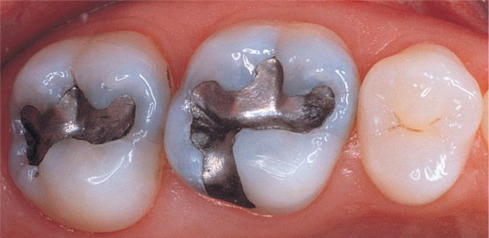Can Mercury Dental Fillings Hurt Your Health?


“Metal in your mouth,” “silver” fillings, dental amalgams – whatever you call them, few people give much thought to the metal fillings in their teeth once the dentist has put them in place. Dental amalgams are a mixture of metals used to fill cavities caused by tooth decay; they consist of 50% metal alloy – a blend of silver, copper, and tin – and 50% elemental mercury. (Source)
While composite and resin fillings are beginning to replace mercury fillings in most dental offices, mercury-containing dental amalgams are still incredibly common. In fact, many people still have mercury fillings in their mouths, even if they were placed decades ago. You would think such a commonplace treatment would have been well-vetted for safety, but there are some significant concerns about the safety of mercury amalgams and their effects on health. (Source)
Keep reading to learn about the history of mercury dental fillings, their potential impact on health - including the gut microbiome, and considerations for their removal.
A Brief History of Mercury Dental Fillings
Point-blank: Mercury is one of the most toxic non-radioactive metals known to mankind. Mercury pollution of our environment through industrial practices is pervasive, yet few of us consider mercury exposure occurring closer to "home" like in your mouth and body.
Early experiments with mercury dental fillings began in the 1830s. As of the early 2000s, the United States used up to 32 tons of mercury annually for dental fillings! (Source, Source)
While the American Dental Association (ADA) asserts that mercury dental amalgam material is a "durable, safe, and effective cavity-filling option," other well-respected sources beg to differ. (Source)
Unfortunately, there is a double mercury standard here in the United States. The EPA and FDA recommend we reduce our intake of mercury-containing fish to 8 ounces or less. Yet, dental amalgams are “safe for adults and children over the age of six.” Frighteningly, autopsy studies suggest that dental amalgam is the primary source of mercury in human tissues. (Source, Source) There is a misconception that mercury fillings are not a source of mercury toxicity when research is indicating mercury from dental amalgam material is equally detrimental to health as mercury found in seafood. (Source, Source)
The Harmful Health Effects of Mercury
Mercury impacts a variety of organs and systems inside the body. Mercury-containing dental amalgams expose the body primarily to elemental mercury, abbreviated Hg0. Studies show that elemental mercury primarily targets the brain. (Source)
Elemental Mercury and the Brain
Elemental mercury is an invisible, odorless vapor. It is readily absorbed across the blood-brain barrier, the cell layer separating the bloodstream from the brain. For this reason, it is known to have toxic effects on the nervous system. In fact, some studies suggest that mercury dental amalgams are associated with neurodegenerative disorders, via the harmful effects of mercury on neurotransmitter production and brain inflammation. (Source, Source, Source)
The primary places that mercury accumulates inside the body are the liver, kidneys, and the central nervous system, which consists of the brain and spinal cord.
Mercury and the Oral and Gut Microbiome
Mercury exposure may disrupt the healthy balance of oral bacteria, resulting in periodontitis, an inflammation of the delicate tissues surrounding the teeth. (Source)
Furthermore, bacteria in the mouth, such as Streptococcus minor, Streptococcus mutans, and Streptococcus sanguis, can methylate (a process of adding a small chemical group – a methyl group) elemental mercury, transforming it into methylmercury. Methylmercury, in turn, is associated with adverse changes in the bacteria that comprise the gut microbiome, increasing levels of hostile and inflammatory gut bacteria. (Source)
Methylmercury may also damage tight junctions in the gut, which are proteins that help hold intestinal cells together, preventing substances from “leaking” from the gut into the bloodstream. Therefore, mercury dental amalgams could contribute to gut microbiome imbalances and leaky gut by altering the microbes and the integrity of the intestine. (Source)
Considerations for Mercury Dental Amalgam Removal
If you’ve reached this point in the article and have mercury dental amalgams, you are likely to be concerned and may begin contemplating having them removed. However, mercury dental amalgam removal is not a situation to be taken lightly. It must be done carefully and thoughtfully by a dentist specially trained in safe mercury dental amalgam removal.
Though the idea of getting your fillings replaced may seem daunting, it can support long term health. It’s not uncommon to find that some chronic, difficult to resolve health issues can been linked to mercury toxicity. Women who are planning to eventually try to conceive (but aren’t pregnant yet) might also consider mercury dental amalgam removal since mercury from dental amalgams may be transported to a growing fetus. (Source)
Research shows that dental amalgam removal emits a significant amount of toxic mercury vapor. Therefore, it is vital to work with a dentist with the proper equipment to safely remove mercury dental amalgams and minimize the toxic release of mercury vapor. The authors of a recent study on this critical topic put it bluntly: "Standard methodologies for occupational mercury exposure assessment appear to be inadequate when assessing mercury exposure during amalgam removal.” (Source)
In other words, if you want to get your mercury amalgams removed, you MUST work with a dentist who is qualified to do so. We recommend checking out The International Academy of Oral Medicine and Toxicology (IAOMT) to find a mercury-literate dentist who are trained to remove mercury dental amalgams.
The Bottom Line on Mercury Dental Amalgams, Health, and the Microbiome
Despite what multiple medical and dental organizations claim about the safety of mercury dental amalgams, a growing body of research suggests that these fillings have various risks to our health, including the health of the oral and gut microbiomes.
If you have mercury fillings and want to be proactive about your health or are currently dealing with a chronic health issue that may be related to your mercury amalgams, consider getting your fillings safely removed by a mercury-literate dentist. You may also want to work with a functional medicine provider who can guide you through a safe, effective mercury detoxification protocol after your fillings have been safely removed.
References
Han, D.-H., Lim, S.-Y., Sun, B.-C., Janket, S.-J., Kim, J.-B., Paik, D.-I., Paek, D., & Kim, H.-D. (2009). Mercury exposure and periodontitis among a Korean population: the Shiwha-Banwol environmental health study. Journal of Periodontology, 80(12), 1928–1936. https://doi.org/10.1902/jop.2009.090293
Jirau-Colón, H., González-Parrilla, L., Martinez-Jiménez, J., Adam, W., & Jiménez-Velez, B. (2019). Rethinking the dental amalgam dilemma: An integrated toxicological approach. International Journal of Environmental Research and Public Health, 16(6). https://doi.org/10.3390/ijerph16061036
Lin, X., Zhao, J., Zhang, W., He, L., Wang, L., Chang, D., Cui, L., Gao, Y., Li, B., Chen, C., & Li, Y.-F. (2020). Acute oral methylmercury exposure perturbs the gut microbiome and alters gut-brain axis related metabolites in rats. Ecotoxicology and Environmental Safety, 190, 110130. https://doi.org/10.1016/j.ecoenv.2019.110130
Mutter, J. (2011). Is dental amalgam safe for humans? The opinion of the scientific committee of the European Commission. Journal of Occupational Medicine and Toxicology, 6(1), 2. https://doi.org/10.1186/1745-6673-6-2
Paduraru, E., Iacob, D., Rarinca, V., Rusu, A., Jijie, R., Ilie, O.-D., Ciobica, A., Nicoara, M., & Doroftei, B. (2022). Comprehensive review regarding mercury poisoning and its complex involvement in Alzheimer’s disease. International Journal of Molecular Sciences, 23(4), 1992. https://doi.org/10.3390/ijms23041992
Palkovicova, L., Ursinyova, M., Masanova, V., Yu, Z., & Hertz-Picciotto, I. (2007). Maternal amalgam dental fillings as the source of mercury exposure in developing fetus and newborn. Journal of Exposure Science & Environmental Epidemiology, 18(3), 326–331. https://doi.org/10.1038/sj.jes.7500606
RN, K. B., PhD, R. L., PhD, C. E., MPH, MPH, D. S., Lindemann, P., & Piff, A. (n.d.). Mercury-Containing Amalgam Fillings Account for Less Than 6% of Posterior Tooth Fillings in 2022. Epicresearch-Prd.azurewebsites.net. Retrieved February 19, 2024, from https://www.epicresearch.org/articles/mercury-containing-amalgam-fillings-account-for-less-than-6-of-posterior-tooth-fillings-in-2022
The American Dental Association Reaffirms its Position on Dental Amalgam. (n.d.). www.ada.org. https://www.ada.org/en/about/press-releases/2020-archives/the-american-dental-association-reaffirms-its-position-on-dental-amalgam
Tian, X., Lin, X., Zhao, J., Cui, L., Gao, Y., Yu, Y.-L., Li, B., & Li, Y.-F. (2023). Gut as the target tissue of mercury and the extraintestinal effects. Toxicology, 484, 153396. https://doi.org/10.1016/j.tox.2022.153396
Torrey, E. F., & Simmons, W. (2023). Mercury and Parkinson’s Disease: Promising leads, but research Is needed. Parkinson’s Disease, 2023. https://doi.org/10.1155/2023/4709322
US EPA, O. (2015, July 30). EPA-FDA Advice about Eating Fish and Shellfish. www.epa.gov. https://www.epa.gov/choose-fish-and-shellfish-wisely/epa-fda-advice-about-eating-fish-and-shellfish#:~:text=The%20Dietary%20Guidelines%20for%20Americans%20recommends%3A
US EPA, O. (2015, September 8). Mercury in Dental Amalgam. Www.epa.gov. https://www.epa.gov/mercury/mercury-dental-amalgam#:~:text=Amalgam%20can%20also%20release%20small
Vandeven, J. A., & Mcginnis, S. L. (2005). An assessment of mercury in the form of amalgam in dental wastewater in the United States. Water, Air, & Soil Pollution, 164(1-4), 349–366. https://doi.org/10.1007/s11270-005-4008-1
Warwick, D., Young, M., Palmer, J., & Ermel, R. W. (2019). Mercury vapor volatilization from particulate generated from dental amalgam removal with a high-speed dental drill – a significant source of exposure. Journal of Occupational Medicine and Toxicology, 14(1). https://doi.org/10.1186/s12995-019-0240-2


